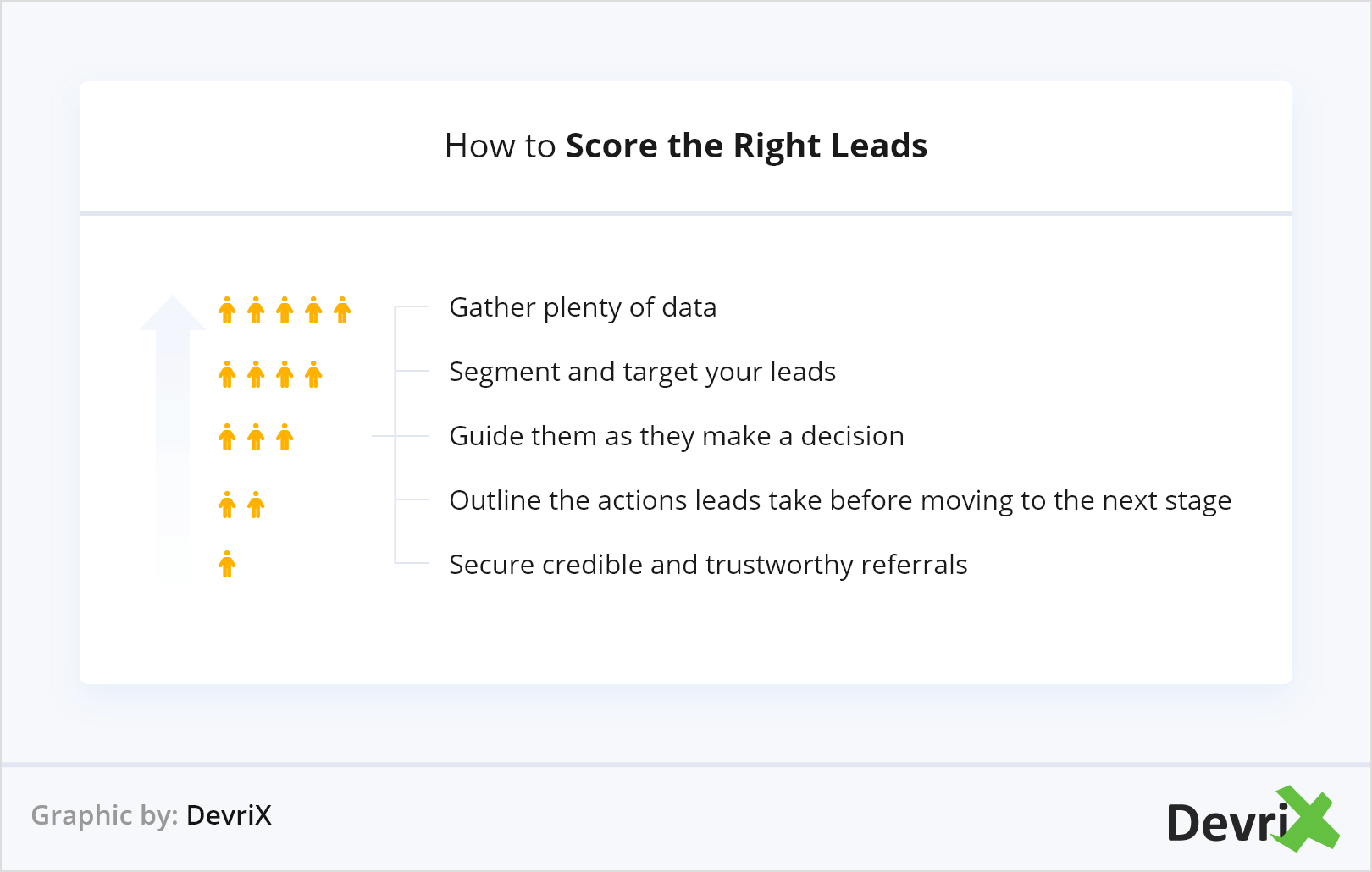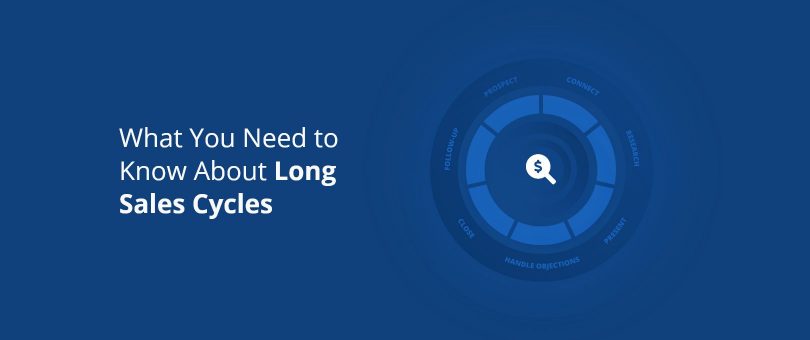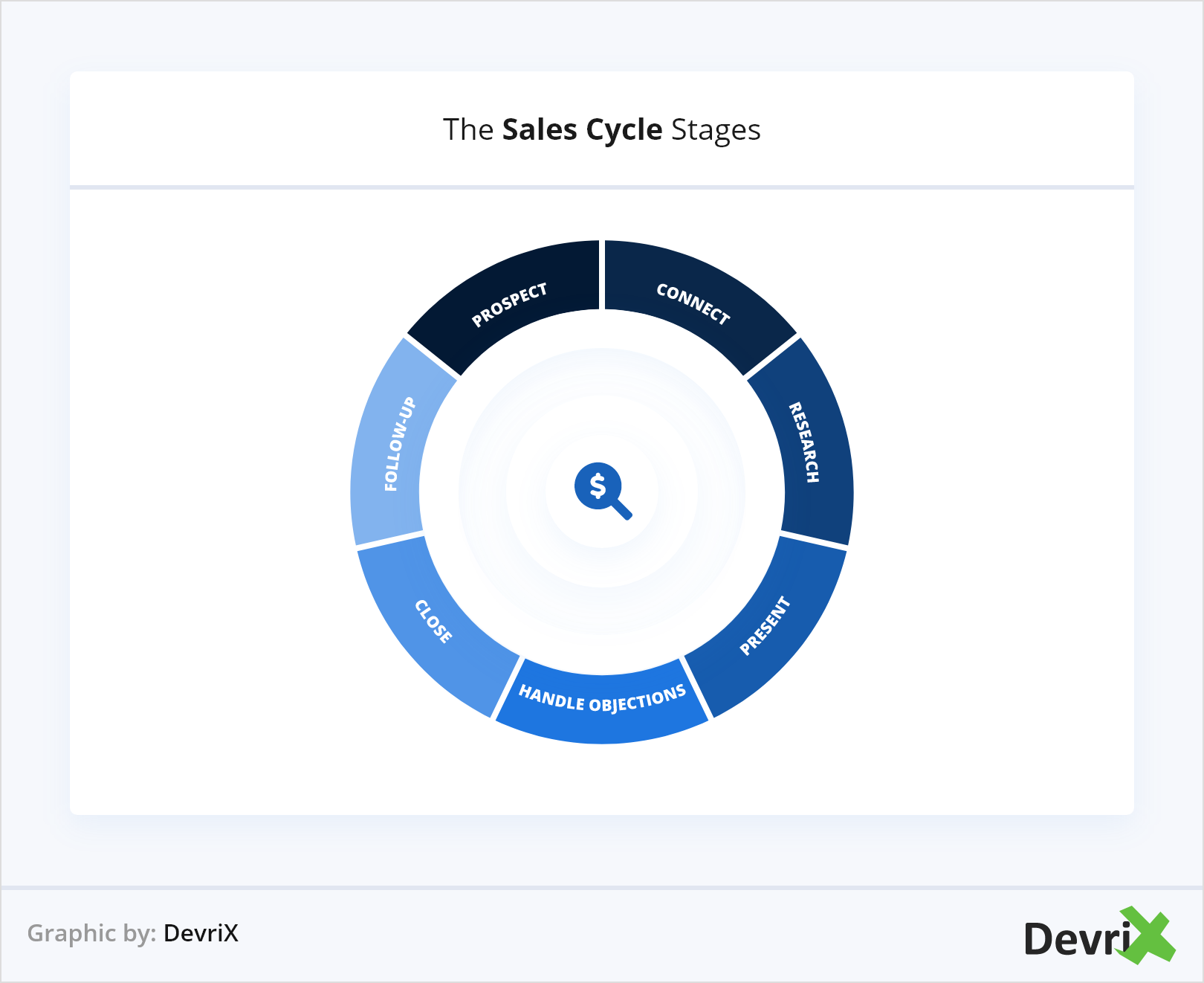In the B2B world, long sales cycles are a common and quite stressful phenomenon. Sales from one business to another are less straightforward than selling to a single customer. On the one hand, there are more stakeholders involved. On the other hand, the products/services being sold are usually more complex, involving larger costs and long-term commitments.
The term sales cycle describes the process which salespeople go through to close a new client. It starts from the first contact with a customer to sealing the deal and following up on it. This process accompanies a potential client on their journey from the moment they realize they have a problem all the way to purchasing a product/service that can solve it. And, while it’s an exploration for the prospects, it’s actually a roadmap for the sales team.
The length of this cycle can also vary depending on the client and the item being sold. According to Step Change, the time period until a sale is closed can last between 3 months for smaller deals and 6, 9, or 12 months for larger ones. And while most companies would want to close deals faster, taking your time with a client can actually help you secure a larger revenue over the longer term.
In this article, we’ll share with you all you need to know about long sales cycles. More specifically, why it’s important to embrace them, when and how you can speed them up, and what are some tips to help you seal the deal successfully.
What Does a Sales Cycle Look Like?
The sale cycle is a process comprising 7 separate stages that follow the client throughout their buyer journey. It acts as an organizational chart that helps salespeople navigate prospects from leads to customers.
Additionally, it allows the reps to better understand at what stage of the buyer experience a person is at so they can adjust their efforts accordingly.
The Sales Cycle in a B2B Scenario
If you’re a small business owner selling to other small businesses, or you offer a subscription service on a monthly basis, your customers will come to you directly. However, if your company caters to larger businesses you would have a more roundabout way of attracting clients, thus having to deal with a longer sales cycle.
In a B2B scenario, the sales cycle is longer due to the following reasons:
- There are multiple stakeholders involved. According to recent data from Gartner, the average B2B buying group can consist of 6 to 10 decision-makers, each of which has at least five pieces of information that they wish to discuss individually.
- It’s generally more expensive. The products/services involved with these types of sales are generally more complex. They meet the demands of entire corporations, not just single individuals. For example, a Spotify subscription vs a music label signing contracts to have their artists’ music distributed on the platform.
- It’s a complicated, high-stake decision. The B2B buyer journey is a non-linear multiple-step process, where clients move back and forth between the different stages of the purchase funnel before making a final decision.
- It includes an extensive competitor review. All the looping around takes significant time and involves an extensive evaluation of all available offers from all competitions offering them.
As you can see, B2B sales are quite complex, so it’s natural that this cycle is longer. If you wish to excel in your sales efforts it’s crucial that you understand all these processes really well.
You also need to know how to approach your leads. So, read on to find out how to score even the toughest ones.
How to Approach a Long Sales Cycle?
According to Entrepreneur, the two main factors for why sales cycles are becoming longer are the Internet and decision paralysis. On the one hand, buyers have an abundance of information right at the tip of their fingers. On the other hand, they are now much more aware of the implications that a wrong decision can bring.
Many businesses shy away from long cycles as the last thing they want is to spend weeks and even months negotiating only to hear a “no”. However, there are quite a few benefits that a longer process can yield.
- The longer you engage with your prospects, the better you’ll get to know them and the higher the likelihood of discovering an untapped need they might have.
- You can build rapport with your leads so you can create a more personalized experience.
- You’ll be able to tweak your product/service according to your prospects’ needs and preferences.
- Following a longer sales cycle can indicate that you’re confident and capable of managing complex, high-revenue deals, and thus cater to larger clients.
- You can examine each stage of the sales process closely and ensure every process is well-optimized to generate the right results.
To use long sales cycles to your best advantage you need to remember 3 things:
- Do your research really well.
- Really listen to what your prospects are telling you.
- Teach them how your product/service can solve their problem.
As mentioned in Forbes, you need to give before you can sell.
In other words, while you’re navigating potential clients throughout their buyer journey, you need to help them warm up, build trust, and show them why you’re their best option.
If you’re not sure how exactly to do that, read on. We have some tips to help you out.
Top 7 Tips to Close Your Sales Faster
Monitoring and managing your sales process is very important for ensuring great monetary success. According to a survey by Harvard Business Review (HBR), there is a strong relationship between effective sales management and revenue growth. Companies with a well-managed sales pipeline can benefit from a higher growth rate, and those that master a few specific practices can expand their business operations even more.
Here are our top 7 tips on how to improve your sales cycle and close your sales successfully.
1. Have a Well-Defined Sales Process
A well-defined sales process can help sales reps measure their performance and make better decisions. The same HBR survey mentioned above also discovered that when businesses invest time in defining a clear, formalized, and credible sales process their reps can do a better job at managing the pipeline. In fact, companies with a formal business process can yield an 18% higher revenue compared to those with an informal pipeline.
Since the sales cycle follows the prospect as they move from leads to clients, in a way it mirrors the buyer journey, but from the sales team’s point of view. As such, every next stage of the cycle should show incremental commitment to solving client needs.
Here’s what you can do to ensure your reps’ efforts don’t go in vain.
- Analyze your current process. – Pin-point what isn’t working and look for ways to fix it and meet your prospect’s needs better. For instance, look at both deals you’ve closed and deals you didn’t. Observe how your reps progressed through the stages and how long each one took.
- Draft the purchase journey of your target client. – Looking at the cycle from the buyer’s point of view can help you gain a better understanding of how they interact with your sales team, and what pain points they may come across.
- Distinguish the actions prospects make when transitioning to the next stage. – When evaluating these, remember to look at what your prospective clients are doing, and not what your reps are perceiving. Think about: what issues your team may come across when scheduling a meeting/call, or what features or objectives moved or stalled the deal respectively.
- Set exit criteria for your salespeople. – Identify what your reps need to do so that prospects can move ahead. For example, in the initial stages, your sales team may need to provide clients with a specific type of content like a testimonial to help close the deal.
- Measure the results of the process. – Keep track of how your cycle is improving and estimate how successfully your team has updated its practices to capture the right clients. Look at average time spent on each stage, percentage of prospects requisitioning a demo or scheduling a call, churn rate, and so on.
Carefully outlining all sales cycle stages and setting specific milestones can help your sales when navigating through the buyer journey. They will know what the current state is of a particular deal and how it should be managed after.
2. Improve Your Sales Management
In addition to having a detailed sales process ready, it’s also important to devote enough time and resources to ensuring everything goes smoothly. To guarantee that your team is successfully moving through the sales cycle, you need to evaluate how much time is devoted to each stage and if it’s spent wisely.

It’s also very important to differentiate between managing and forecasting. This is an honest mistake that can happen to many sales teams, so it’s necessary to avoid it. If you find yourself discussing probabilities, deal sizes, or closing dates – you’re forecasting. However, if you are talking about the health of your overall sales process and what your reps can do to close more deals successfully – you’re managing.
The main focus during sales team meetings should be to develop a better action plan that can help your reps move deals forward effectively. It’s more than making data observations and predicting revenue. In fact, it’s about taking those numbers apart to see what you can do better and more efficiently.
3. Coach Your Sales Reps
To ensure your salespeople can close long-cycle deals successfully, you have to prepare them to do so. Coaching your reps means providing them with targeted training that addresses particular sales challenges.

It’s about teaching your team how to make better decisions. You need to know at what point within the sales cycle your reps’ actions have the biggest impact. Then you structure your meetings in a way you can provide coaching rather than inspections.
Here are 5 areas to focus on to ensure you can provide proper coaching:
- Ask, Don’t Tell -Your sales reps would respond better to your training if you ask them questions about what would be an appropriate next step, instead of directly telling them what to do. By doing this you’ll nurture your team to take ownership of the solution and help them make better decisions on their own.
- Advocate for Self-Evaluation – Take the time to follow up with your reps after the client call/meeting. Give your feedback and encourage them to evaluate their own performance. This will help them see what they did and how well they did it, so they can improve and become more self-aware.
- Improve One Area at a Time – There’s always room for improvement, but if you try to define all the processes at once, it will only overwhelm your team. So, take it one cycle stage at a time and invite your team members to point out inefficiencies themselves. This way they’ll be more committed and motivated to improve as a whole.
- Let Them Draw Their Own Action Plan – A clear sales cycle process shows the milestones your reps should reach, but how those are reached can differ from person to person. So ask guiding questions and let your team members set their own agenda. This way they’ll be able to build and sustain momentum towards change.
- Hold Them Accountable – Once your salespeople are done with their plan, you need to make sure they truly commit to it. You can ask them how successful it was based on their results, were there any challenges with it, how they overcame them, and so on.
Sales coaching is a process with many nuances, but its power lies in the premise that the sales reps have the answers and need to be held responsible.
4. Score the Right Leads
Not all leads are created equal, and sending every potential client directly to sales won’t guarantee they’ll become a qualified lead. Yet, 61% of B2B marketers end up forgetting about this, which slows down the process. This is because when unqualified leads fall into the mix, the sales pipeline gets clogged.

To ensure you devote your time and resources to the right prospects, you should evaluate your leads carefully and differentiate between those who’re only browsing and those willing to buy. Hence when a quality lead shows a serious interest in your product/service you can nurture it more efficiently.
In fact, according to Salesforce lead nurturing can yield 20% more sales opportunities. Here are a few things you can do to score the right ones successfully:
- Gather enough data, make a list of all your leads, and prioritize the high-quality ones.
- Segment and target the leads at each stage of the sales cycle with tailored messages.
- Guide your prospects to making a decision, don’t push them into it.
- Set up benchmark criteria that can indicate the actions your leads need to take to become sales-ready.
- Secure credible and trustworthy referrals.
Prospecting, nurturing, and scoring the right leads in a B2B context is a complex process, so learning and adopting powerful strategies is very important if you want to move through the sales cycle successfully.
5. Spend Your Time in Meetings Wisely
Victory loves preparation, just like a successful sales close needs a well-defined process, it also calls for proper planning of your client meetings.
It’s necessary to set a robust agenda with clear goals and share it with your client ahead of time. This will help everyone stay focused and allow for productive discussions addressing any concerns as they arise. Moreover, it will show your professionalism, credibility, and trustworthiness.
When planning a meeting, be clear about the reasons for it and set the objectives you want to achieve. Outline the talking points and check that they are of interest to your clients, so you can take them to the next sales cycle stage.
Additionally, leave room for spontaneous discussions. Set time aside to answer any questions that come up in the meeting. Put effort into providing thorough responses, and follow up later if there’s additional information that needs attention. Actively participate by asking questions yourself, so your reps can later evaluate the success of the meeting.
Finally, reach back after the conversation ends. Send an email with a recap of what you discussed. Ask for confirmation of the actions that need to be taken next and always finish off with clearly defined next steps.
6. Align the Sales and Marketing Efforts
As today’s sales cycles become more complex and thus longer, they introduce challenges for both marketers and salespeople. However, when the two teams align, they can address them more quickly and better.

This process of adjustment needs some planning as well, but once set, it can help ensure long-term success. According to MarketingProfs, this coordination improves productivity and helps to better source business opportunities. In fact, when sales and marketing are in sync you can benefit from a 38% increase in sales win rates and a 36% increase in customer retention rates.
So, here are some actions you can take:
- Define common terms, goals, and strategies.
- Have the two departments sit through client calls together.
- Assign one person of each team to be the liaison between the two.
- Encourage them to brainstorm together.
- Make sure that your content can be beneficial to both – it should be timely, driven by the client’s needs, and easy to use by the sales teams.
By doing everything necessary to support your sales and marketing teams you’ll be able to shorten your sales cycle, be more effective at nurturing your leads, and close more deals successfully.
7. Automate Where You Can
The more leads you have in your sales pipeline, the more difficult and time-consuming it will be to manage them manually. Automating manual tasks will improve your reps’ productivity, accuracy, and efficiency. It will also help streamline the processes and enhance the performance quality.
One particularly important sales automation solution you can adopt is a Customer Relationship Management (CRM) tool. With it, you can support your reps through the whole sales cycle so they can easily track, organize, and nurture prospects to prevent any leads or clients from getting ignored or being forgotten.
Salesforce has stated that a CRM tool can increase sales productivity by 14.5%. This will give your reps the necessary time to focus on well-qualified leads and thus guide them through the cycle faster.
The type of CRM system you choose will strongly depend on your business needs and the types of customers you interact with.
In the case of B2B operations, it’s important to source out a tool that can support the complexities of sales cycles – i.e. a large number of leads, more steps in the sales process, and high amounts of lead-specific data.
Conclusion
The stakes in the B2B world are high because the sales cycles are complex and include many individuals. Hence why they’re longer, requiring consistent efforts from your sales team.
Today’s shoppers have access to plenty of information both when researching for a product. To close them successfully, you need to have a few key practices in place.
Starting from a well-defined sales process, great time management, effective coaching and cross-team coordination, and automating as many processes as possible, there are plenty of favorable sales opportunities to capitalize on.
We hope you’ve found our tips helpful. If you would like to learn more, don’t hesitate to check more of our articles, and contact us.








![Influencer Marketing Statistics Every Business Should Know [Infographic]](https://devrix.com/wp-content/uploads/2019/10/Influencer-Marketing-Statistics-Every-Business-Should-Know-Infographic@2x-380x160.png)